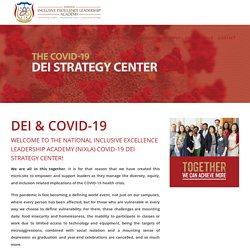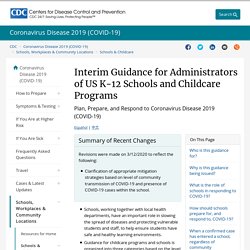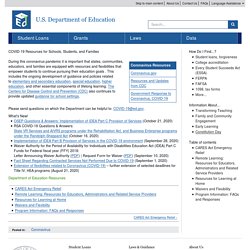

Email aelkordy@nl.edu. Resources for Remote Teaching - Leadership in a Pandemic. Trauma-Aware Teaching Checklist. ISTE OnlineLearningResourceSampler. Education Now. Education Now Webinars Education Now webinars, hosted by HGSE's Richard Weissbourd, will be broadcast via Zoom each Wednesday, streaming live on Facebook, and available for later viewing on YouTube, Facebook, and this website.

Latest Episode: The Path Forward Host Richard Weissbourd speaks with Professor of Education, Meira Levinson and Clint Smith (Ed.M.'17, Ph.D.'20) about what needs to happen now to prepare educators, families, and communities for a new vision of K-12 education.May 20, 2020 Episode 5: Teaching to Navigate Challenge and Uncertainty A conversation with Harvard's Sarah Dryden-Peterson (Ed.D.’09) and Boston Public Schools elementary superintendent Ana Tavares (Ed.M.’99). We'll talk about preparing young people — and ourselves — to adapt to change, confront inequities, and strengthen our communities in a time of turmoil.May 13, 2020 Confronting the Coronavirus Outbreak.
Online Tools for Teaching & Learning – Designed by students in EDUC 595A at the University of Massachusetts Amherst. Welcome to Online Tools for Teaching and Learning!

This site was designed to help you identify online tools that you might use for teaching or learning. Each page includes a wealth of information about a specific tool (e.g., price, ease of use, description of the tool, innovative ways to use the tool for teaching and learning, how the tool fits with the SAMR model) to help you evaluate the tool and determine whether to use it in your practice. This site was created as part of a collaborative class project at the University of Massachusetts Amherst. DEI & COVID-19 - The National Inclusive Excellence Leadership Academy. We are all in this together.

It is for that reason that we have created this micro-site to empower and support leaders as they manage the diversity, equity, and inclusion related implications of the COVID-19 health crisis. This pandemic is fast becoming a defining world event, not just on our campuses, where every person has been affected, but for those who are vulnerable in every way we choose to define vulnerability. For them, these challenges are mounting daily: food insecurity and homelessness, the inability to participate in classes or work due to limited access to technology and equipment, being the targets of microaggressions, combined with social isolation and a mounting sense of depression as graduation and year-end celebrations are cancelled, and so much more.
Please take advantage of the resources shared on this page to support your efforts now and into the future. We will update the site regularly, so we encourage you to return frequently, to get updates. An Online Gathering to Share and Support Educators During the Coronavirus Pandemic. Online learning buddies - Help & Be Helped. Center for Interactive Learning - CILC Interactive Content for Distance Learners.
Khan Academy schedules for school closures. Copy of Education Companies Offering Free Subscriptions due to School Closings. School Closure Planning Document. Joint Response Regarding COVID-19 and Transitioning Face-to-Face Courses Online. Schools, Workplaces & Community Locations. Interim Guidance for Childcare Programs and K-12 Schools. This interim guidance is based on what is currently known about the transmission and severity of coronavirus disease 2019 (COVID-19).

The US Centers for Disease Control and Prevention (CDC) will update this guidance as needed and as additional information becomes available. Please check the CDC COVID-19 website periodically for updated interim guidance. Health officials are currently taking steps to prevent the introduction and spread of COVID-19 into US communities. Schools play an important role in this effort. Through collaboration and coordination with local health departments, schools should take steps to disseminate information about the disease and its potential transmission within their school community. COVID-19: Preparing For Widespread Illness in Your School Community. With special thanks to the National Association of School Nurses (NASN) for its input and collaboration Your communities are likely paying attention to media reports of the rising numbers of cases of respiratory illness and deaths caused by a new coronavirus that is now present in the U.S.

This guide is intended to inform school district leaders about the federally identified risks associated with this particular virus and to provide a checklist of issues school leaders should consider as you plan for any such crisis in your community. [2] The new virus, which causes mild to severe respiratory illness, is called ”SARS-CoV-2,” and the disease it causes I known as “COVID-19.” It is unknown at this time how many people may become ill. The U.S. government is working closely with state, local, tribal, and territorial partners, as well as public health partners, to respond to this public health threat. COVID-19 ("Coronavirus") Information and Resources for Schools and School Personnel. COVID-19 Resources for Schools, Students, and Families Coronavirus Resources Coronavirus.gov.

Understanding the Impact of Coronavirus on K-12 Education [Webinar Series] Learning Keeps Going. COVID-19 Online Learning Resources and FAQ. We are compiling some of the best resources and exemplars for schools and families preparing for online learning in response to COVID-19 As COVID-19 spreads rapidly in the United States, schools and districts are facing difficult decisions around how to protect their students and staff while continuing to prioritize learning and equity.

As of March 13, 2020, more than 21,900 schools have been closed or are scheduled to close, including seven state-wide closures plus the District of Columbia, because of exposure or cleaning needs, impacting some 15 million students. 127 individual schools or districts have reopened. Home. IDEA - Illinois Digital Educators Alliance - Resources for Creating an e-Learning Classroom.
We are in unprecedented times but we know that as dedicated and passionate educators, together we will find a way to rise up and create positive opportunities for those we serve.

With that, the IDEA staff has been gathering suggestions and resources to support you during your planning and preparation for possible e-learning within your districts. We have attempted to compile information for all grade levels and for whatever current learning platforms you may be using. We wish each of you the best and please know that we are here to support you! We will be utilizing #IDEAil & the #ILedChat to share questions and best practices throughout the next few weeks. In addition, we can find other creative ways to make the best out of this difficult situation, including setting up virtual meetings with you and/or your students, creating unique learning experiences, sharing resources, or just to listen and give feedback. General Advice Remember your WHY! Www.amazingeducationalresources.com.
Teaching Remotely for Grades K - 12. 50 elearning activities, templates and tutorials - Ditch That Textbook. Distance learning solutions. The list of educational applications, platforms and resources below aim to help parents, teachers, schools and school administrators facilitate student learning and provide social care and interaction during periods of school closure.

Most of the solutions curated are free and many cater to multiple languages. While these solutions do not carry UNESCO’s explicit endorsement, they tend to have a wide reach, a strong user-base and evidence of impact. They are categorized based on distance learning needs, but most of them offer functionalities across multiple categories. Digital learning management systems Systems purpose-built for mobile phones Systems with strong offline functionality Can’t wait to Learn (link is external) – Gaming technology to deliver quality education to children, including those in conflict contexts. Remote Learning/Extended Closure Digital Learning Plans. COVID-19 support resources. IDEA - Illinois Digital Educators Alliance - IDEAs for @Home Learning. With school closures, teachers can keep their lessons going remotely: Jennie Magiera, GoogleGlobal Head of Education Impact, founder@OurVoiceAll, and bestselling author of #CourageousEdventures pulled together some strategies for shifting to a remote learning environment.

In addition, consider registering for this 2 part webinar series: Making the transition to remote learning: To help make the transition to distance learning, Microsoft has created resources, training and how-to guides that we hope will help support IT, educators, staff and students as they make this transition. E-Learning Alternatives: Strategies that keep the focus on the learning target during remote learning experiences. Read the World Distance Learning Support - Virtual Workshop. COVID-19 support resources. Elearning - Ditch That Textbook. Schools all over the world are closing their doors due to health concerns. So many of them are turning to eLearning, distance learning, remote learning. Trying to make sense of it? Trying to just keep your head above water? The Virtual Presenter's Guide to Using Zoom Meeting Tools. This guide is designed for virtual presenters, trainers, and facilitators who use Zoom Meetings.
It includes some of the most commonly used features of Zoom for interactive virtual meetings, presentations, and other live online learning sessions. Joint Response Regarding COVID-19 and Transitioning Face-to-Face Courses Online. ID-ER Network. Companies & Organizations Offering Time-Limited Access to Resources During Coranavirus Crisis - Google Sheets. How to Convert a Face-to-Face Class to Online/Remote Learning — Dr. Luke Hobson. Why did I layout the information this way? Let’s first start with the reading. The reading is an indication for what is to come next. Think of it as a priming exercise for the brain. By providing this type of background information first, students will be more engaged with the video content because there is already a slight element of applying prior knowledge. By having a reading on one topic and then following this with the same topic in a more expansive video, it’s a nice pairing that will aid in the overall understanding of the content.
Next, let’s talk about the practice question. Finally, you’ll notice something called a “reflection question.” My example above is not to confine a teaching style to only practice questions and reflection questions. Recording Videos From here, I would record videos using Zoom. Teaching Remotely in Times of Need - Google Slides. Distance learning solutions. Covid-19: Resources for Faculty and Institutions – Cengage. Crowdsourcing Teaching Online with Care. COVID-19. We have all been tracking the spread of COVID-19, and we’ve been speaking with our community of schools to learn about what impact this is having on them and their students, how they’re handling the disruption, and what they need moving forward. What we’re finding is that there are a range of needs for both students and educators—some of whom are struggling and others who are thriving. We would like to help all our students have a positive learning journey until this ends.
Over the past nine years, GOA has identified and trained educators in best practices for remote learning. There are a few key points that need to be understood. First, online learning is all about connecting with others and fostering the relationships we have with our students and colleagues. (From our Executive Director Michael Nachbar's letter to the GOA community) Best Practices: Online Pedagogy. 20 Collaborative Learning Tips And Strategies For Teachers. 20 Collaborative Learning Tips And Strategies For Teachers contributed by Miriam Clifford There is an age old adage that says, “two heads are better than one.”
Consider collaboration in recent history: Watson and Crick or Page and Brin (Founders of Google). But did you know it was a collaborative Computer Club about basic programming at a middle school that brought together two minds that would change the future of computing? Yes, those two were, of course, Bill Gates and Paul Allen, the founders of Microsoft. Tinkerpost: Volume 1. Dear Wowzer Families and Teachers that Wow, Video - Stuff for bilingual kids. Circletime. Free distance learning tools during coronavirus outbreak. 150+ Enrichment Activities for Children While Parents are Working Remotely.
Disaster Preparedness Tips for Families Affected by Autism - Autism Society. Disaster Preparedness Tips for Families Affected by Autism With the help of renowned emergency preparedness expert Dennis Debbaudt, who has a son with autism, former Autism Society Board Member Ruth Elaine Hane, and support from NASCAR driver, Jamie McMurray — the Autism Society is committed to helping families with special needs prepare for emergencies. During any emergency, a health crisis, natural disaster or man-made, it is necessary to be prepared with a plan and essentials. Tip #1. Practice calm Parents and care providers need to project a demeanor of calm during a disaster or emergency, even if we’re not feeling it!
Tip #2. Be ready to evacuate. Create a self-help network of relatives, friends or co-workers to assist in an emergency. If you think you may need assistance in a disaster, discuss needs with relatives, friends and co-workers and ask for their help. Give a key to a trusted neighbor or friend who may be able to assist you in a disaster. 1. 1. 1. Tip #3. Tip #4. Talking to Children About COVID-19 (Coronavirus): A Parent Resource. A new type of coronavirus, abbreviated COVID-19, is causing an outbreak of respiratory (lung) disease. It was first detected in China and has now been detected internationally. While the immediate health risk in the United States is low, it is important to plan for any possible outbreaks if the risk level increases in the future.
Concern over this new virus can make children and families anxious. Transitioning to Remote Teaching Blog Series – Post 1: Teacher Well-being – MAET Blog. Meditation Apps for Kids. Educators' Well-Being During the COVID-19 Outbreak. I Will Survive, Coronavirus version for teachers going online.